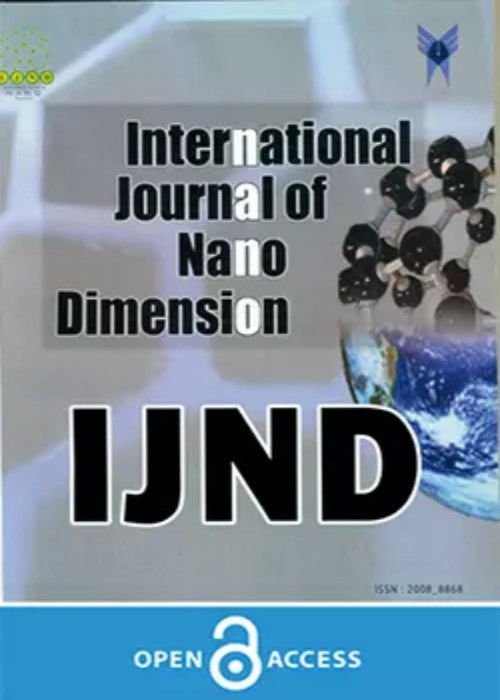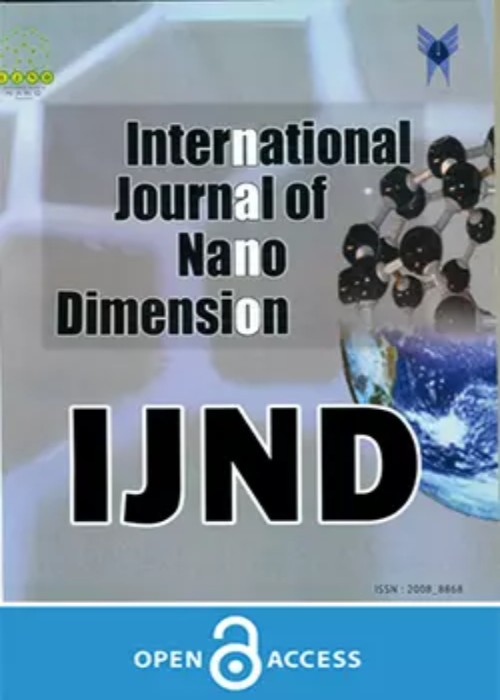فهرست مطالب

International Journal of Nano Dimension
Volume:14 Issue: 4, Autumn 2023
- تاریخ انتشار: 1402/09/04
- تعداد عناوین: 8
-
-
Pages 286-303
As nanomaterials are being continuously used in the health sector, the cosmetic sector is believed to be the most advanced for using nanoparticles in their products. In order to increase the effectiveness of cosmetic goods, the cosmetic industry is profoundly exploring nanomaterials. Liposomes, dendrimers, nano-emulsions, etc. are examples of nanomaterials that are now common constituents in the cosmetic industry. This article highlights the applications and challenges of nanomaterials in the cosmetics sector. Nanoparticle-based cosmetics have expanded the possibilities of nano cosmetics use to treat dispersed hyperpigmentation, dehydrated, and wrinkled skin diseases that are related to aging. It offers excellent opportunities for both business and academic research. On the other side, there are a lot of safety-related issues that are always getting more attention. That’s why it is necessary to discuss both applications as well as the challenges of applying nanotechnology to cosmetics. Based on all the applications as well as the challenges, it can be concluded that nanomaterials used in cosmetics have substantial health advantages and are helpful, however, they must be sensitively described to ensure their safe usage and total removal from the body. As a result, nano cosmetics products must be produced and marketed with the utmost regard for both the environment and consumer health.
Keywords: Nano Cosmetics, Nano-emulsions, Nano Pigments, Nano-somes, Nanostructured Lipid Carriers -
Pages 304-319
This study aimed to use D-optimal combined design, and partial least squares discriminate analysis (PLS-DA) to investigate the mechanical properties, and chemical compatibilities of improved epoxy nanocomposites by nano TiO2/Al2O3. Experimental design of adhesion, and wedge bend properties led the results into the optimum values of TiO2= 0.66%, Al2O3= 1.33%, dispersant= 0.000017%. The variable importance of the projection (VIP) score and PLS-DA modeling were used to categorize mechanical properties and chemical compatibilities. The best point could be identified from the other samples, based on the results. PLS-DA could explain 94.32% of the total variance in the data and wedge bend, adhesion and thermal treatment were the most significant variables with VIP scores at 2.73, 2.02, and 1.38, respectively. The morphology was examined using a field emission scanning electron microscope (FESEM). The thermal properties of nanocomposites were described by differential scanning calorimeter (DSC) to define the glass transition temperature for epoxy-nanocomposites. The mechanical properties were measured to assess the storage modulus via the dynamic mechanical analysis (DMA). Epoxy/TiO2/Al2O3 nanocomposite exhibited a uniform particle distribution, as indicated by the FESEM image. Adding nanoparticles significantly raised the glass transition temperature. The presence of nanoparticles can be used to enhance storage modulus functionally.
Keywords: Chemical Properties, DMA, DSC, FESEM, Mechanical Properties -
Pages 320-330
The highly lightweight and thermal insulator polyvinyl alcohol (PVA) doped fiber-embedded silica aerogel blankets was prepared with different types of fibers. The performances of PVA-doped silica aerogel blankets were compared. The silica aerogel blankets were prepared by integrating different fibers with encapsulated the PVA during the aging process. The synergic effect of PVA doping-derived silica aerogel blankets on the thermal conductivity, surface physical characteristics and young modulus were investigated. Consequences revealed that PVA-encapsulated blankets could diminish the thermal conductivity, porosity, and density of the aerogel blanket. The prepared blankets have shown further properties intensely without significant reduction. Experimental outcomes exhibited the properties of improvement in thermal conductivity (in the range of 0.023-0.035 W/m.K), density (in the range of 0.051 - 0.118 g/cm3), and Young Modulus regarding the pure silica aerogel. The prepared PVA-based aerogel blanket has prospective in various sectors such as the production of spacecraft apparel, military jackets, clothes for fire-fighting and hilly areas people from low-temperature protection.
Keywords: Ambient Pressure Drying, Dust-Free Silica Aerogel Blanket, Nanoporous, Polyvinyl Alcohol (PVA) Encapsulation, Thermal Insulator, Mechanical Robust -
Pages 331-338
This paper presents the synthesis and characterization of nanocomposites made from Activated Carbon and Phenol-Formaldehyde, known for their exceptional thermal properties, chemical stability, and affinity for graphite and other forms of carbon. These composites are primarily designed for high-temperature applications that demand strength retention. X-ray diffraction (XRD) analysis reveals a distinct carbon peak in the nanocomposites, while Fourier-transform infrared (FTIR) spectroscopy indicates the presence of functional group peaks in their respective regions. The aim of this study is to provide a detailed account of the chemical synthesis and characterization of activated carbon/Phenol-Formaldehyde nanocomposites. The results of the XRD and FTIR analyses demonstrate the presence of a sharp carbon peak and functional group peaks in their respective regions. These properties render the composites suitable for high-temperature applications requiring strength retention.
Keywords: Bakelite, Carbon, Charcoal, Phenol Formaldehyde Nanocomposites, XRD -
Pages 339-347
By the importance of customizing appropriate carriers for the specific drugs to approach a successful drug delivery process, the drug delivery of aspirin (ASP) was assessed by the assistance of an iron-enhanced nanocone (FCONE), using density functional theory (DFT) calculations. ASP, CONE, and FCONE models were optimized to be prepared for involving in bimolecular interactions to form ASP@CONE and ASP@FCONE complexes along with re-optimization calculations and vibrational frequency confirmations. Benefits of the enhanced FCONE model were seen for better interacting with the ASP counterpart comparing with the CONE and ASP interactions within the evaluated values of -26.35 and -10.07 kcal/mol for the corrected binding energies to yield a meaningful “recovery time” term. Additionally, the electronic molecular orbital features showed a priority for a better detection of ASP counterpart by the FCONE, in which the variations of energy gap values yielded a meaningful “conductance rate” especially for the ASP@FCONE complex. As a consequence, the recognized models of ASP@CONE and ASP@FCONE complexes were learned by a better advantage of enhanced FCONE model to be worked a s better proposed carrier for the ASP drug delivery process.
Keywords: Adsorption, DFT, Drug Delivery, Molecular Interaction, Nanocone -
Pages 348-355
In this framework study, an attempt was made to synthesize, characterize, and develop some applications of nano AlF3 (nAF) by sol-gel method. Meanwhile, precursor gel preparation and the interaction on the nano-sized area have been studied. By nAF the ZnAl2O3/AlF3 (ZA) nanocomposite has been successfully prepared and Structural, morphological and thermal characterization has been done using by FT-IR, XRD, SEM, TG-DTG, and HRTEM techniques. This nanocomposite was used for the removal of Congo red dye. For this purpose, the morphology and the structure of crystals has been changed by modification on precursor gel. When precursor gel has been changed from 4 to 9 h, the size of crystals decreased to 15-20 nanometers. The results showed that ZA have been efficiency for photocatalysts in decolorization of Congo red.
Keywords: Activity of Catalist, Condo red, Nano AlF3, Poly Vinyl Choloride, Sol-gel, XRD -
Pages 356-365
The sciences that intrigue about nanotechnology are increased ever before and improved permeability in its applications at various arenas. Precisely, the Silver nanoparticles (AgNPs) implication is deep-time perspective to understand that fascinating nanomaterials are involved in different biomedical applications. Since NPs application derivates are physical and chemical based but biological methods is still holds a profound impact. Hence, the medicinal plant Strobilanthes ciliata was utilized to synthesis AgNPs and the same was subjected to UV irradiation. And subsequent application of the crude biosynthesis of AgNPs was experimented with various physico-chemical parameters. Biosynthesized particle characterization was carried out by color pattern and UV-visible spectroscopy and followed by FTIR, SEM and finally experimenting with cancer cells as cyto-toxic study. The characterization result of particle size of synthesized AgNPs is 77 nm. The highest peak obtained in FTIR is at 3439.48cm−1 (OH) and the UV range is 477 nm. As far as the cancer cells are concerned, the cell survival rate at 1 mcg is 62% and at 1.5 mcg is 30% which is optimal. The lattice planes of XRD are face-centered-cubic (FCC) structure. The Particle size of S.ciliata mediated AgNPs is 77.7 nm. Biological methods attain much concern and forethought because bio-resources are used as precursors in synthesis of NPs. Therefore, herein we exclusively have done the plant-mediated metallic NPs synthesis, characterization and applications in detailed summary. The present research observation will hold enrich understanding about AgNPs interaction and the mode of synthesis with various expertise and subject.
Keywords: Cancer Cells, Characterization, Green Chemistry, Nanomaterials, Strobilanthes Ciliata -
Pages 366-372
Bactericidal effect of copper oxide is still a growing area of research even though a lot of experiments have been carried out by the researchers. The present work was designed to explore structural and optical properties of micro-size copper oxide particles (µCuO) synthesized using microwave irradiation. Synthesized samples were characterized with ultraviolet-visible spectroscopy, Fourier transform infrared spectroscopy, x-ray diffraction and scanning electron microscopy. Scanning electron micrographs revealed the formation of rod-shaped copper oxide in micron size. X-ray diffraction pattern showed the synthesized microparticles are in monoclinic phase. Solutions of µCuO with various concentrations from 1% to 15% were prepared using dimethyl sulfoxide for the antibacterial study. Starting from 2% concentration, µCuO started to produce a good inhibition zone around the Bacillus subtilis bacteria. The prepared µCuO displayed splendid results in bactericidal activity against Bacillus subtilis bacteria. Higher concentrations of the µCuO showed strong action against bacterial growth. Micro-size copper oxide can also be used as an antibacterial agent like nano-size copper oxide.
Keywords: Antibacterial, FTIR, Microstructure, Rapid Synthesis, X-ray Techniques


